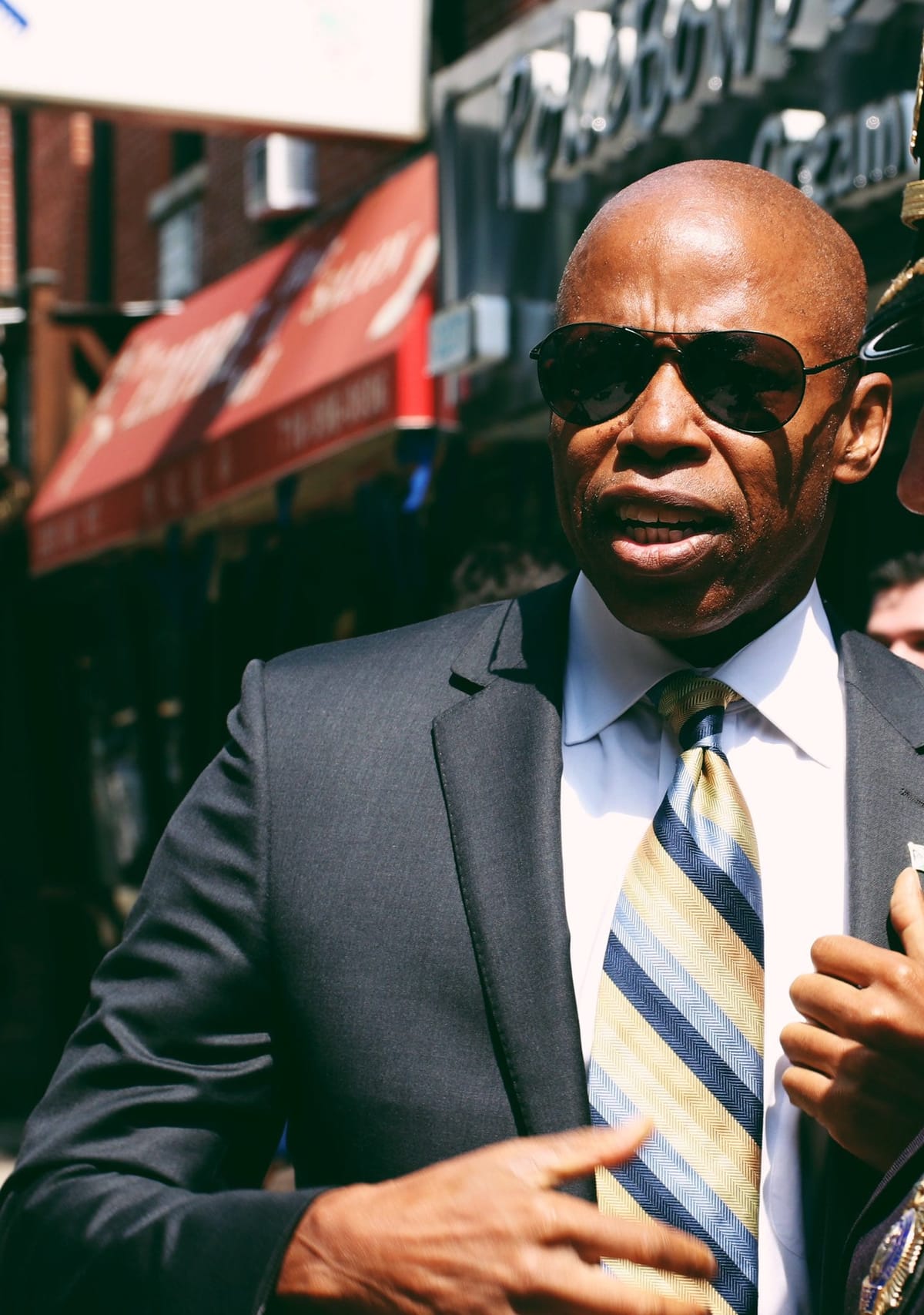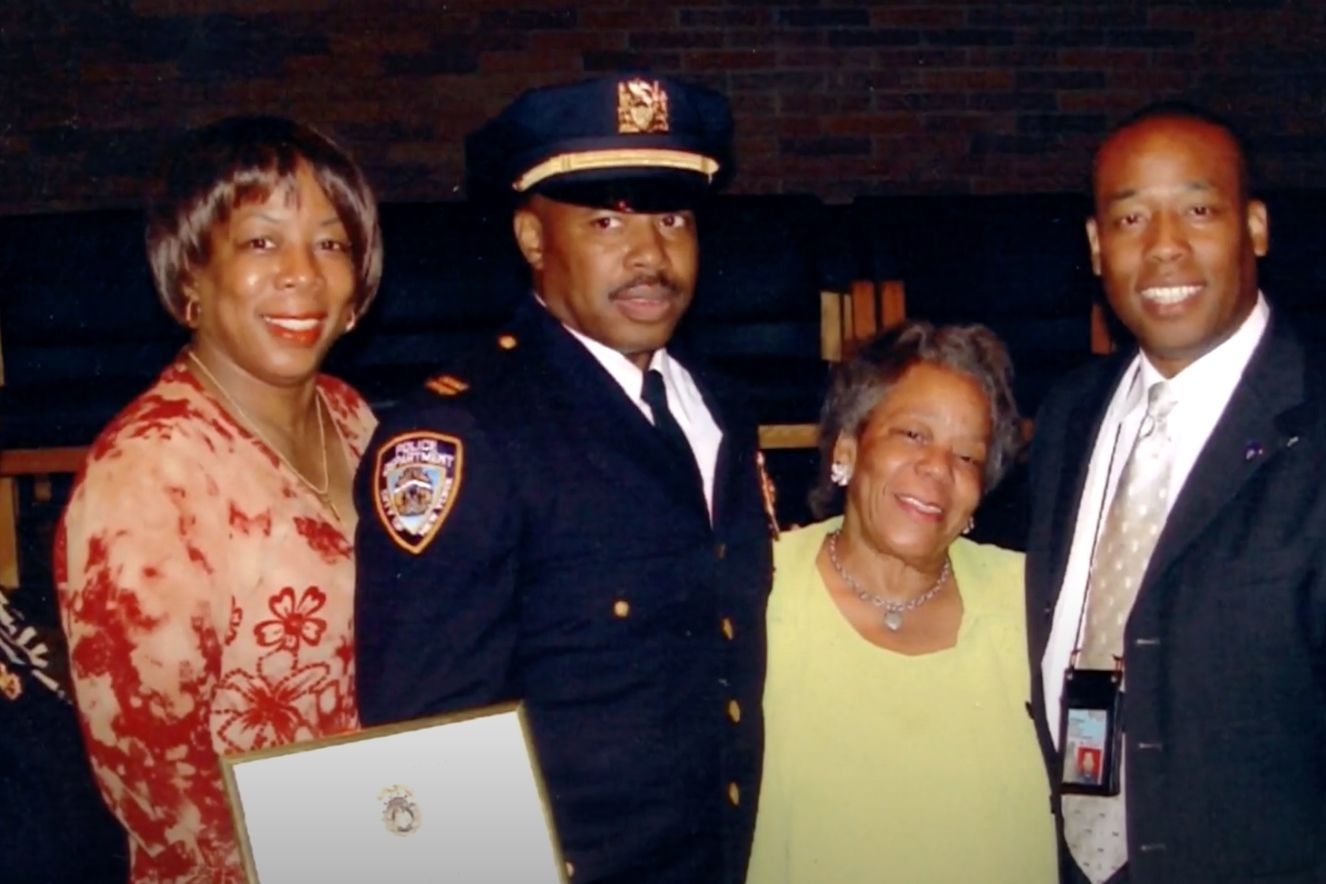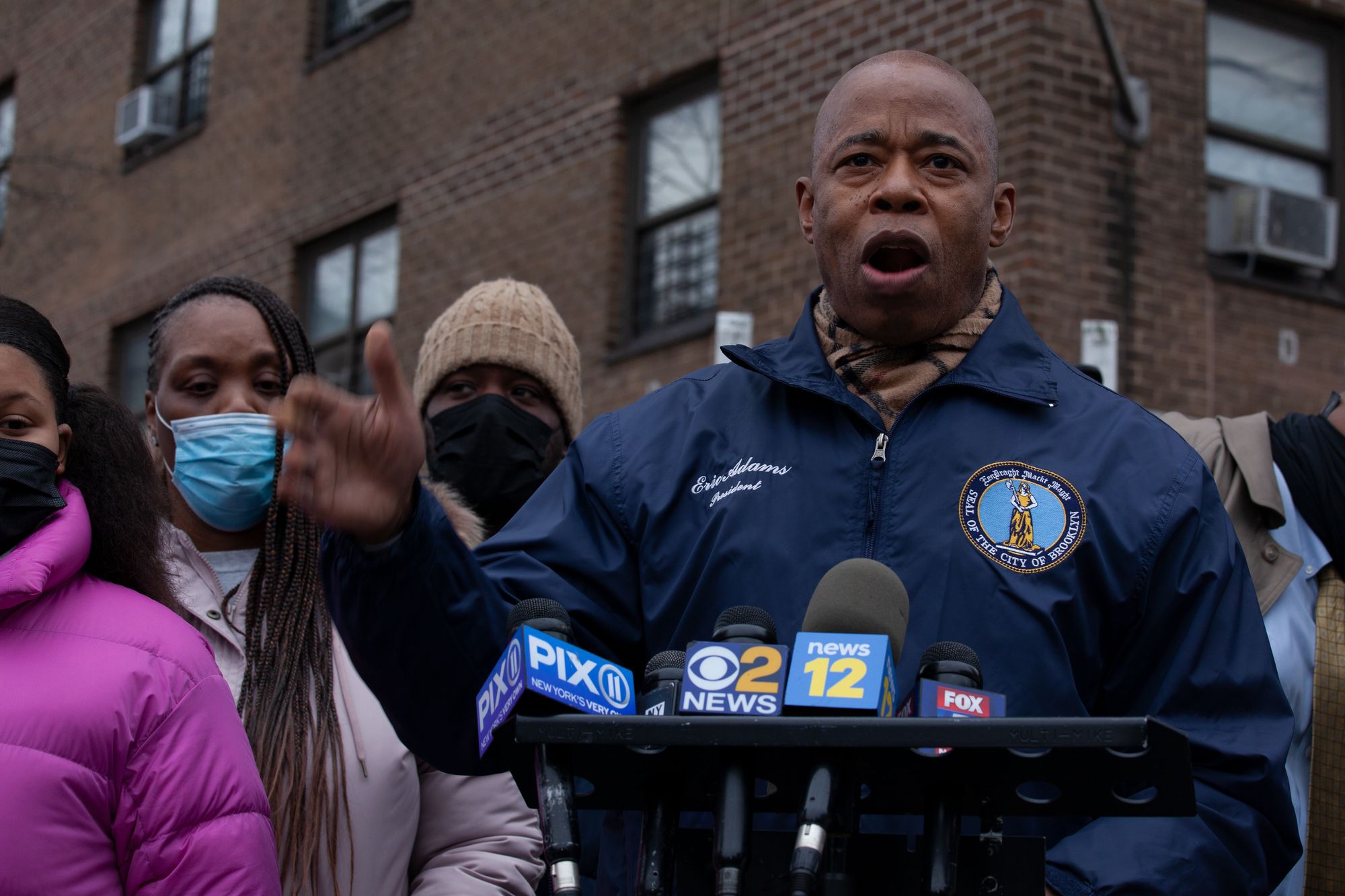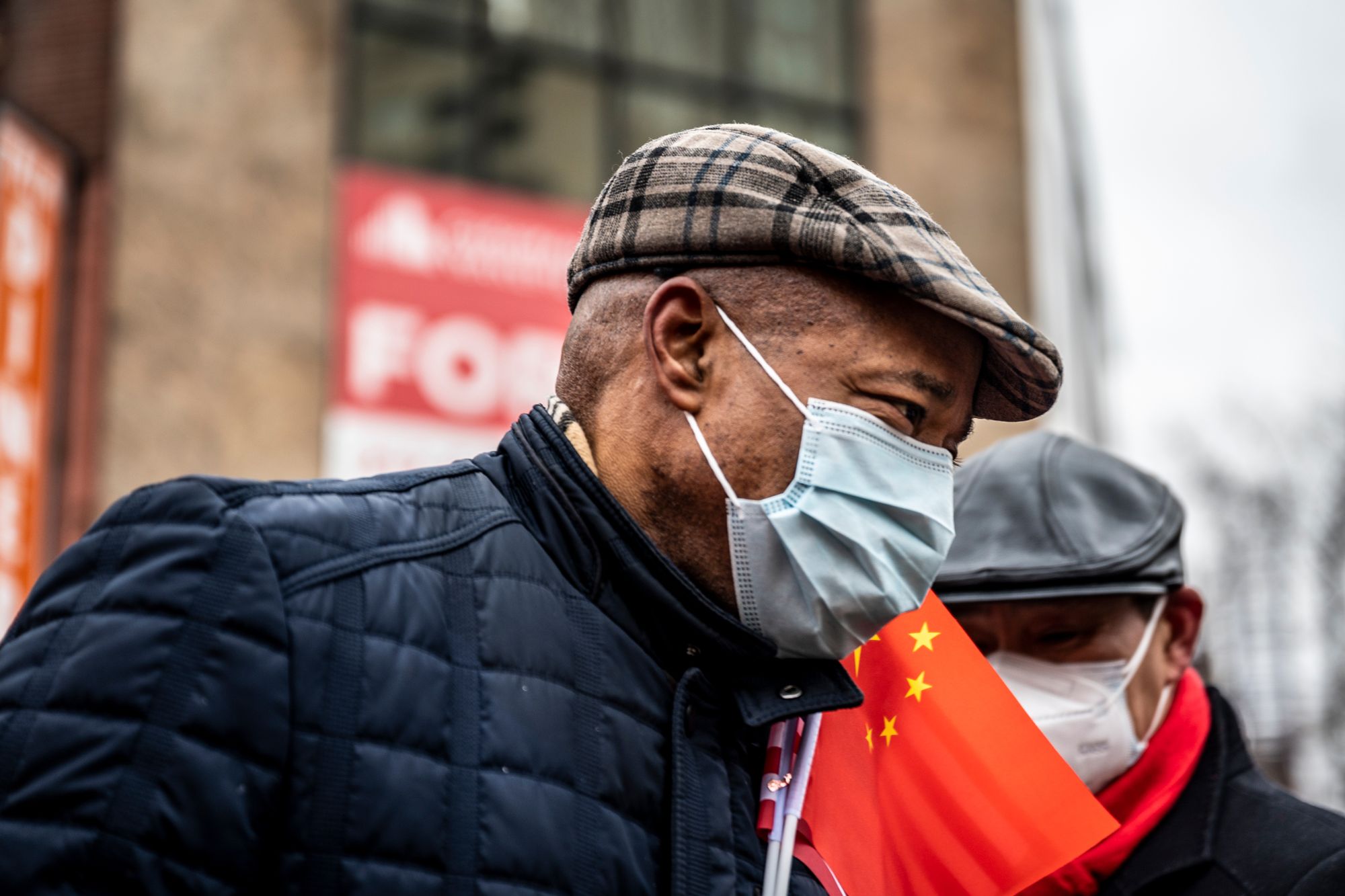Eric Adams Reveals Fellow Cop May Have Shot at Him. Now the NYC Mayoral Candidate’s Record as an NYPD Critic and Target Takes Center Stage


By Greg Smith, THE CITY. This article was originally published by THE CITY

The Brooklyn borough president’s 22 years on the force brought multiple internal investigations — including for associating with felon Mike Tyson. “When I look back, I’m amazed I was able to get out of the department alive,” he told THE CITY.
In the predawn hours of Jan. 19, 1996, long before he was a candidate for mayor, then-NYPD Sgt. Eric Adams turned left off Atlantic Avenue onto Classon Avenue in Brooklyn. He was heading home after studying for the lieutenant’s exam at a friend’s house.
That’s when he noticed the dark-colored sedan pull inside his lane and a gun barrel pointing out of the driver’s side window. And that’s when he heard someone in the car call his name.
Adams stomped on the accelerator and the bullet hit the rear window of the car he was driving, shattering the glass. And all these many years later, Adams can’t help but wonder if the shooter was actually one of his fellow police officers.
“I’m not sure,” he told THE CITY. “I was at the peak of the fight with the Police Department. I don’t know if some officer, someone in their drunken rage, said, ‘Enough of this guy.’”
Adams was, at the time, a former chair of the Grand Council of Guardians, a fraternal group of Black cops, and co-founder of 100 Blacks in Law Enforcement Who Care — both of which frequently and publicly blasted the NYPD for failing to serve Black New Yorkers and Black officers.
Now he is running for mayor as he nears the end of his second and final term as Brooklyn’s borough president — and speaking publicly for the first time about the chilling shooting incident.
“When I look back, I’m amazed I was able to get out of the department alive,” Adams, 60, told THE CITY.

At the time somebody took a shot at him, Adams said, he’d long been catching hell from some fellow cops and many of the department’s top brass for his persistent criticism of the NYPD.
“I was getting a lot of harassment,” he said. “I was getting a lot of threats.”
He also was the subject of multiple internal investigations, including one for associating with boxer Mike Tyson, a felon for his 1992 rape conviction. Another involved a man convicted of federal weapons charges affiliated with the group that pulled off a deadly 1981 Brinks robbery in Nyack — an association Adams addressed directly for the first time in an interview with THE CITY.
A Very Different City
Adams’ 22-year tenure with the NYPD informs his campaign for mayor on a host of criminal justice issues, from addressing the rallying cry of “defund the police” to making sure the mostly white top tiers of the department become significantly more racially and ethnically diverse.
While on the force, Adams bashed the department, sometimes for its poor relationship with Black and Hispanic communities, sometimes for what he saw as institutionalized hostility toward Black and Hispanic officers.
From the time he joined in 1984 to when he retired in 2006, Adams was investigated four times by the Internal Affairs Bureau (IAB). At one point, he told THE CITY, he received a ping on his beeper every night at 11 p.m. sharp with no discernable number. Then one day a number popped up, and he asked Internal Affairs to see where it came from.
“IAB meets with me, [they say] the phone that has been beeping you is a phone that’s registered to IAB,” he said. “Can you imagine the level of hate? For five years all you thought about was, ‘Let me beep Eric Adams.’”
In all these internal investigations, Adams lost a total of 15 vacation days as punishment — for an unauthorized TV appearance.
Two other accusations were found to be unsubstantiated, and another was closed without a formal finding. He was never the subject of a civilian complaint alleging on-the-job misconduct, and he managed to rise to the rank of captain.
Adams’ time in the department spanned a remarkable period in New York City: He started at the beginning of the crack epidemic and was there when the number of major crimes climbed skyward, then dropped like a rock.
In those early years, the city was a very different place. The number of murders hit 1,450 the year Adams joined the force, increasing to a record high of 2,245 in 1990.
Starting out as a transit cop, he was assigned to what was then known as District 34 in Coney Island. He and his partner would ride the subway all night long on the 8 p.m. to 4 a.m. shift.
“Radios didn’t operate correctly,” he said. “There were many days when, if there was an altercation, you had to be smart. Don’t do it while you’re going across the bridge. Don’t do it while you are in a tunnel.”
Stop-and-Frisk Rises
Adams recalled the practice of cops banging their batons against steel subway pillars as they entered stations, hoping for backup.
“The sound a baton makes is unique,” he said. “You’d hope there was a cop in the station.”
Then in the 1990s, the tide turned. The number of major crimes began dipping. In 2005, Adams’ last full year on the job, the number of murders had dropped by 75% from its 1990 peak to 539.
By 2019, the number bottomed at 317, before spiking back up last year to 447 during the COVID-19 pandemic.
There are many theories to explain the turnaround that occurred during the years Adams was a cop. But one of the tactics the NYPD embraced during that time ultimately brought with it lasting damage: the misuse of stop-and-frisk.
Although the crime rate had already dropped dramatically, the department greatly accelerated the deployment of cops to stop and question New Yorkers. Those targeted were predominantly Black and Hispanic young men. Between 2002 and 2006, when Adams left the force to run for state Senate, the annual number of these stops rose from 97,000 to 400,000, according to NYPD statistics.
A federal judge ultimately declared that the racial imbalance of these stops demonstrated that the NYPD’s employment of stop-and-frisk violated the constitutional guarantee of equal protection under the law.
Adams testified during the trial that led to that ruling, claiming that then-Police Commissioner Ray Kelly — the architect of the stop-and-frisk boom — once told him the reason cops were stopping mostly Black and Hispanic youth was to “instill in them a fear that anytime they leave their homes they can be stopped and searched by police.”
Kelly denied saying that.
Critic From Within
Adams joined the force, he has often said, after having endured a brutal beating by cops as a teenager growing up in Brooklyn. He says he was recruited by Black civil rights leaders to become a police officer as a way of fighting for reform from within.
The record shows that is precisely what he did.
In 1989, he became chair of a coalition of Black police fraternal groups known as the Grand Council of Guardians. Six years later, he co-founded 100 Blacks in Law Enforcement Who Care, a group that pushed the NYPD to diversify what was then a mostly white department in a mostly Black, Hispanic and Asian city.
Frequently in the headlines or on TV, Adams became the subject of multiple accusations of poor judgment and dubious intentions. His critics came to believe his non-stop attacks on the department that employed him did more harm than good.
Retired NYPD veteran Wilbur Chapman, 73, who became one of the highest-ranking Black employees in the department, first as chief of patrol and then as a deputy commissioner, contends Adams’ constant hectoring undermined the NYPD’s struggle to patch up its strained relationship with the Black community.
“The idea is to try to correct those deficiencies and show the Black community that it can be trusted, that it’s there to be a helpful resource,” Chapman said. “By constantly making accusations, some of them baseless, and when you get media attention, people believed what they saw in print and on TV.”
The result of such attacks, he said, was hesitation among Black New Yorkers to join the NYPD or even cooperate with police investigations: “That was not helpful when you had the Police Department trying to reach out to the community.”
Chapman said Adams’ regular news conferences spent a disproportionate amount of time attacking then-Police Commissioner Howard Safir. Chapman said he believed Safir, appointed in 1996 by then-Mayor Rudy Giuliani, was trying to increase the diversity of the uniformed force.
“It was particularly offensive to me, one as a New Yorker and also as a member of the department. All he would do is attack Commissioner Safir, who was extremely concerned about diversity in the department,” he said. “He never had one instructive idea, never had a suggestion, but had to go out there angry every Sunday. That looked like a self-serving platform and it was.”
‘Very Bad Guys’
Adams’ public criticism of the NYPD generated a wave of resentment — and even hate. He became the frequent subject of ridicule in the vitriolic public chat room known as Thee RANT where NYPD cops vent their inner resentments under the veil of anonymity.
The 1996 shooting incident came at a time when Adams was in the headlines frequently chastising the department. He had just co-founded 100 Black Men and had recently told Black cops they should refuse undercover assignments, after white officers mistakenly shot a Black undercover named Derwin Panell they thought was committing a robbery.
Speaking with THE CITY, Adams noted that at the time someone took a shot at him, the department had endured a series of officer corruption cases. In one 1993 prosecution, a gang of cops dubbed “the Morgue Boys” was charged with robbing drug dealers of narcotics and cash and selling drugs — sometimes while on duty.
“The Morgue Boys in the 73rd Precinct? These were very bad guys,” he said.
It was particularly unnerving, he said, that the shooter knew his name.
“They said ‘Eric Adams.’ I don’t know if someone was actually following me. It was late. I was coming from studying,” he said. “They knew who I was, that was for sure. Thank God they called out my name. If they had just shot, I don’t believe I would have had time to respond.”
Adams said when he drove to the nearby 88th Precinct, the sergeant on duty advised him not to file a report. At the time, the NYPD said detectives canvassed the area and were unable to uncover any evidence. Adams says they simply dropped the investigation.
Adams found himself on the other side of that line several times over the years. Four times the NYPD’s Internal Affairs Bureau opened investigations into his actions.
The first time was in 1995, when Adams traveled with several other NYPD cops to Indiana to escort boxer Mike Tyson from prison after he’d served time for rape. IAB looked into whether Adams had violated a patrol guide rule barring cops from “associating” with “a person reasonably believed to be engaged in, likely to engage in or to have engaged in criminal activities.”
In an interview, Adams said he’d been asked to accompany Tyson by a former mentor of the boxer from Brooklyn. The mentor “asked me can we go with [Tyson] on his release to make sure he gets home correctly, speak with him after being out as law enforcement officers about how to turn his life around.”
Although Adams was certainly aware that he was escorting a convicted felon, he questioned whether that activity qualified as a violation of the patrol guide.
“Associating with a known felon — you sit down, you’re having activities with them…it’s not being around a known felon,” he said. “Many people in law enforcement, particularly if you come from a high crime community, you know people, you have brothers in the [criminal justice] system.”
He added, “I was never brought up on any official charges.”
Brinks Robbery Case
IAB opened a second probe in 1998 after Adams was seen at a Harlem protest with a convicted felon named Omowale Clay. Again, investigators sought to determine if Adams had violated the rule about not associating with felons.
Clay was one of the Manhattan Eight: a group of self-described Black nationalists charged by federal prosecutors in 1985 with plotting to rob banks and to free two of their peers jailed for their roles in a 1981 armored car robbery in Rockland County. That incident ended with a Brinks guard and two local police officers slain by the robbers.
In 1985, Clay, along with six other members of the Manhattan Eight, was acquitted of conspiracy charges but convicted of federal weapons possession charges. The FBI had found a cache of guns, prison guard uniforms and homemade bombs in apartments used by the group.
For 11 months, IAB staked out Adams and reviewed records of his incoming and outgoing phone calls, seeking to “establish an association between certain individuals,” according to court testimony by a top IAB official.
IAB ultimately closed the case as unsubstantiated — neither proven nor disproven. At the time, Adams was informed about the nature of the probe but refused to talk about it with the press.
In his interview with THE CITY, he addressed what had happened for the first time.
He said he’d attended a rally at a Harlem church and afterward made what he described as a chance acquaintance with Clay.
“I had no idea who Mr. Clay was. The rally was finished. I’d seen him at the rally. We made eye contact. I saw him standing out front,” Adams recalled. He said he offered Clay a ride and dropped him off at a nearby subway stop.
He says he learned of Clay’s background years later, and takes no position on Clay’s involvement in the Manhattan Eight case.
“At a different time in New York history, I committed my life to stopping crime,” he said. “My understanding is that they were not found guilty of conspiracy but they were found guilty of weapons charges. I’m a big believer that people should be held accountable for the charges they face.”
Praise for Nation of Islam
Adams also made a point of referencing the FBI’s notorious COINTELPRO initiative of the 1950s and 1960s, when the bureau illegally targeted groups from the Ku Klux Klan to the Black Panthers to disrupt their activities by planting false allegations meant to trigger internal disputes and potential prosecutions.
“Back then a lot of Black people were being brought up on charges. COINTELPRO was real,” Adams said.
Adams has, in the past, aligned himself with another Black nationalist group, the Nation of Islam. During an unsuccessful run for Congress in 1993 while he was still a cop, Adams touted the actions of the Nation of Islam, looking past the rampant anti-Semitism of its leader, Louis Farrakhan, to praise what he called the group’s “non-traditional methods” fighting crime in the Black community.
His opponent, incumbent Rep. Major Owens, criticized Adams for the alliance. Adams today says that was a misunderstanding of the relationship.
“Owens misinterpreted what I was doing with the Nation of Islam. It wasn’t an endorsement. It was a crimefighting initiative,” he told THE CITY, pointing to a Nation of Islam youth program aimed at reducing crime at a Queens public housing development.
Regarding Farakkhan’s statements, Adams stated: “I’m not a Muslim. I don’t subscribe to these groups. That is not my philosophy. I believe in the Christian philosophy.”
‘Extremely Difficult’ Relationship
IAB also investigated an accusation filed by a Black member of the NYPD’s Street Crimes Unit stating that 100 Blacks in Law Enforcement had pressured him to make negative statements about the unit, records obtained by THE CITY show.
That was in March 1999, a month after four white members of that unit fatally shot a Black New Yorker, Amadou Diallo, after he reached for his wallet and they claimed they thought it was a gun.
IAB ultimately determined the charges to be unsubstantiated. Adams now contends the investigation came in retaliation for his criticism of the NYPD.
“The only thing it adds up to is, ‘You know what? We need to get rid of him.’ They had a non-stop mission to find a way to get me out of the Police Department,” he said.
And in 2006, days after he put in his papers to retire, the NYPD brought disciplinary charges against him after he went on WCBS-TV and discussed the department’s response to an alleged terrorism threat the previous October.
Police officials alleged that Adams wrongfully disclosed department business and appeared on a newscast as a representative of the NYPD without permission. In March 2006, a police trial commissioner cleared Adams of wrongful disclosure but found him guilty of doing the TV appearance without permission.
He was docked 15 vacation days. But by then he’d left the force to run for state Senate and, two terms later, for Brooklyn Borough president.
Adams’ critics say his history with the NYPD could work against him if he becomes the first former cop elected mayor since William O’Dwyer 75 years ago. Chapman, for one, believes it would be “extremely difficult” for a Mayor Adams to deal with a department that remembers his years of critiques.
“You have to be able to balance the two entities and you have to be seen as fair to both. Eric has a history of throwing rocks at the Police Department,” Chapman said. “Where is Eric going to start? Is he going to win over the [police officer] union? If he wins over the union, which backed Trump, he’s going to look bad to the community.”
‘We Can’t Go Backwards’
But as both a critic and a uniformed member of the department, Adams says he possesses a unique understanding about how to respond to recent demands for major NYPD reform.
He is now a registered Democrat but was once a registered Republican, while still on the force, from 1997 through 2001. His positions, unlike those of some of the other mayoral candidates, are not reflexively progressive. He has, for instance, rejected the call to “defund the police.”
“I know what crime does,” he told New York Magazine in November. “You cut the Police Department and you are going to get rid of a lot of Black and brown women, single mothers, who are providing for their families.”

He recently drafted a plan to shift funding away from the uniformed services, increase civilian staff and reduce the overall police budget by $1 billion.
“We can’t go backwards,” Adams told THE CITY. “Our city must be saved but you can do it without placing people in danger. But in all ways, the Police Department must become more efficient in how they’re using taxpayer money.”
Adams notes that none of the other current mayoral candidates — with the exception of Maya Wiley, who was once a federal prosecutor — has any on-the-ground experience in the criminal justice system.
“I think there’s a lot of smart people who don’t understand the complexities of the Police Department,” he said. “When you understand the agency, you can weed through all of that.”
THE CITY is an independent, nonprofit news outlet dedicated to hard-hitting reporting that serves the people of New York.



